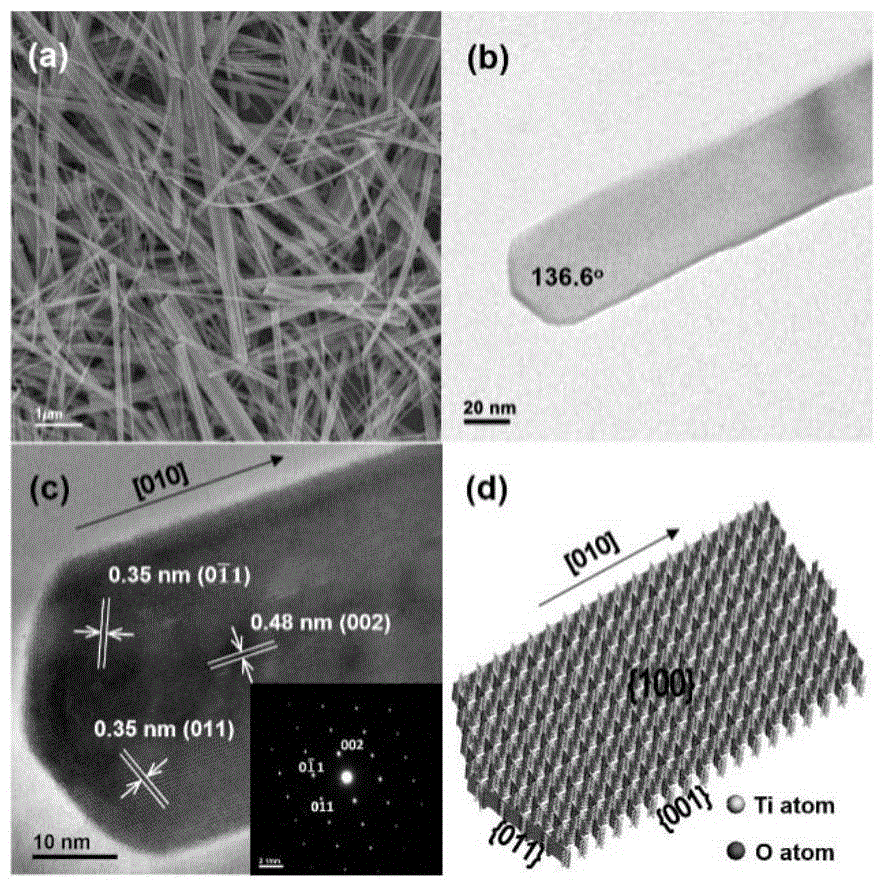Catalyst for photocatalytic degradation of antibiotic as well as preparation method and application thereof
A catalyst and photocatalysis technology, which is applied in the field of environmental technology and water treatment, can solve the problems of low catalytic efficiency of enrofloxacin hydrochloride, low catalytic efficiency of catalyst, complex catalyst synthesis method, etc., and achieve high photocatalytic activity and degradation efficiency, The use method is simple, the synthesis method is simple and the pollution-free effect
- Summary
- Abstract
- Description
- Claims
- Application Information
AI Technical Summary
Problems solved by technology
Method used
Image
Examples
Embodiment 1
[0046] This example is one of the preparation and experiment examples of the titanium dioxide catalyst used for photocatalytic degradation of antibiotics according to the present invention.
[0047] 1. Preparation of catalyst:
[0048] 1) Preparation steps:
[0049] a. At room temperature, diffuse 1 gram of titanium dioxide powder (anatase structure, with a purity of 99.9%) into 50 milliliters of 5 mol / L sodium hydroxide solution, and magnetically stir for 10 minutes to obtain a milky white titanium dioxide suspension;
[0050] b. Transfer the titanium dioxide suspension to a 100 ml polytetrafluoroethylene-lined reactor for homogeneous hydrothermal reaction. The reactor rotation speed is 20 revolutions per minute, the temperature is 200°C, and the hydrothermal time is 24 hours;
[0051] c. Centrifuge and wash the reaction product obtained in step b to neutrality to obtain a white paste precipitate; disperse and soak the paste precipitate in 50 ml of 0.1mol / L hydrochloric acid...
Embodiment 2
[0066] This example is one of the preparation and experiment examples of the titanium dioxide catalyst used for photocatalytic degradation of antibiotics according to the present invention.
[0067] 1. Preparation of catalyst:
[0068] a. At room temperature, diffuse 0.5 gram of titanium dioxide powder (anatase structure, with a purity of 99.9%) into 30 milliliters of 5 mol / L sodium hydroxide solution, and magnetically stir for 10 minutes to obtain a milky white titanium dioxide suspension;
[0069] b. Transfer the suspension to a 100 ml polytetrafluoroethylene-lined reactor for homogeneous hydrothermal reaction. The temperature is 220° C., the hydrothermal time is 24 hours, and the reactor rotation speed is 20 revolutions per minute. white paste precipitate;
[0070] c. Centrifuge and wash the reaction product obtained in step b to neutrality to obtain a white paste precipitate; disperse and soak the paste precipitate in 30 ml of 0.1mol / L hydrochloric acid solution, and magn...
Embodiment 3
[0082] This example is one of the preparation and experiment examples of the titanium dioxide catalyst used for photocatalytic degradation of antibiotics according to the present invention.
[0083] 1. Preparation of catalyst:
[0084] a. At room temperature, diffuse 2 grams of titanium dioxide powder (anatase structure, with a purity of 99.9%) into 80 milliliters of 5 mol / L potassium hydroxide solution, and magnetically stir for 10 minutes to obtain a milky white titanium dioxide suspension;
[0085] b. Transfer the milky white suspension to a 100 ml polytetrafluoroethylene-lined reactor for homogeneous hydrothermal reaction. The reactor rotation speed is 20 revolutions per minute, the temperature is 200°C, and the hydrothermal time is 24 hours;
[0086] c. Centrifuge and wash the reaction product obtained in step b to neutrality to obtain a white paste precipitate; disperse and soak the paste precipitate in 100 ml of 0.1mol / L hydrochloric acid solution, and magnetically stir...
PUM
| Property | Measurement | Unit |
|---|---|---|
| Length | aaaaa | aaaaa |
| Thickness | aaaaa | aaaaa |
Abstract
Description
Claims
Application Information
 Login to View More
Login to View More - R&D
- Intellectual Property
- Life Sciences
- Materials
- Tech Scout
- Unparalleled Data Quality
- Higher Quality Content
- 60% Fewer Hallucinations
Browse by: Latest US Patents, China's latest patents, Technical Efficacy Thesaurus, Application Domain, Technology Topic, Popular Technical Reports.
© 2025 PatSnap. All rights reserved.Legal|Privacy policy|Modern Slavery Act Transparency Statement|Sitemap|About US| Contact US: help@patsnap.com



